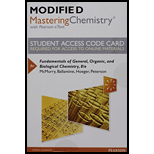
(a)
Interpretation:
The symbol should be identified when the isotope contains 6 protons and 8 neutrons.
Concept introduction:
Atom:
Every atom is composed of a nucleus and one or more electrons bound to the nucleus. The nucleus is made of one or more protons and typically a similar number of neutrons.
Isotope:
Isotopes are variants of a particular chemical element which differ in neutron number whereas protons number is same. Isotopes are same
The element symbol, atomic number and mass number can be written as follows,
A is Mass number (The total number of protons and neutrons in an atom) and it is written in the superscript.
Z is atomic number of the element and it is written in subscript.
X is the symbol of the element
(b)
Interpretation:
The symbol should be identified when the isotope contains 19 protons and 39 mass number.
Concept introduction:
Atom:
Every atom is composed of a nucleus and one or more electrons bound to the nucleus. The nucleus is made of one or more protons and typically a similar number of neutrons.
Isotope:
Isotopes are variants of a particular chemical element which differ in neutron number whereas protons number is same. Isotopes are same atomic number but different in the mass number.
The element symbol, atomic number and mass number can be written as follows,
A is Mass number (The total number of protons and neutrons in an atom) and it is written in the superscript.
Z is atomic number of the element and it is written in subscript.
X is the symbol of the element
(c)
Interpretation:
The symbol should be identified when the isotope contains 10 electrons and 20 mass number.
Concept introduction:
Atom:
Every atom is composed of a nucleus and one or more electrons bound to the nucleus. The nucleus is made of one or more protons and typically a similar number of neutrons.
Isotope:
Isotopes are variants of a particular chemical element which differ in neutron number whereas protons number is same. Isotopes are same atomic number but different in the mass number.
The element symbol, atomic number and mass number can be written as follows,
A is Mass number (The total number of protons and neutrons in an atom) and it is written in the superscript.
Z is atomic number of the element and it is written in subscript.
X is the symbol of the element
Want to see the full answer?
Check out a sample textbook solution
Chapter 2 Solutions
Modified Mastering Chemistry With Pearson Etext -- Standalone Access Card -- For Fundamentals Of General, Organic, And Biological Chemistry (8th Edition)
- The atomic mass number of an atom is determined by the sum of the number of in the atom. (a) protons plus electrons plus neutrons (b) protons plus electrons (c) neutrons plus electrons (d) neutrons plus protonsarrow_forwardExplain the boiling point of a compound ?arrow_forwardWhat is the empirical formula of a compound that contains 72.0% carbon, 12.0% hydrogen and 16.0% oxygen by mass?arrow_forward
- What is the mass in grams of 6.022 * 1023 O atoms of mass 16.00 amu?arrow_forwardHow many protons, electrons, and neutrons are present in the following ? Magnesium cation (Mg2+), Chloride anion (Cl-), Carbon -14(14C), and Tritium (3H)?arrow_forwardHow many electrons must a nitrogen atom, Z = 7, gain to attain a noble gas configuration?arrow_forward

 Concepts of BiologyBiologyISBN:9781938168116Author:Samantha Fowler, Rebecca Roush, James WisePublisher:OpenStax College
Concepts of BiologyBiologyISBN:9781938168116Author:Samantha Fowler, Rebecca Roush, James WisePublisher:OpenStax College Principles Of Radiographic Imaging: An Art And A ...Health & NutritionISBN:9781337711067Author:Richard R. Carlton, Arlene M. Adler, Vesna BalacPublisher:Cengage Learning
Principles Of Radiographic Imaging: An Art And A ...Health & NutritionISBN:9781337711067Author:Richard R. Carlton, Arlene M. Adler, Vesna BalacPublisher:Cengage Learning Biology (MindTap Course List)BiologyISBN:9781337392938Author:Eldra Solomon, Charles Martin, Diana W. Martin, Linda R. BergPublisher:Cengage Learning
Biology (MindTap Course List)BiologyISBN:9781337392938Author:Eldra Solomon, Charles Martin, Diana W. Martin, Linda R. BergPublisher:Cengage Learning Biology Today and Tomorrow without Physiology (Mi...BiologyISBN:9781305117396Author:Cecie Starr, Christine Evers, Lisa StarrPublisher:Cengage Learning
Biology Today and Tomorrow without Physiology (Mi...BiologyISBN:9781305117396Author:Cecie Starr, Christine Evers, Lisa StarrPublisher:Cengage Learning




